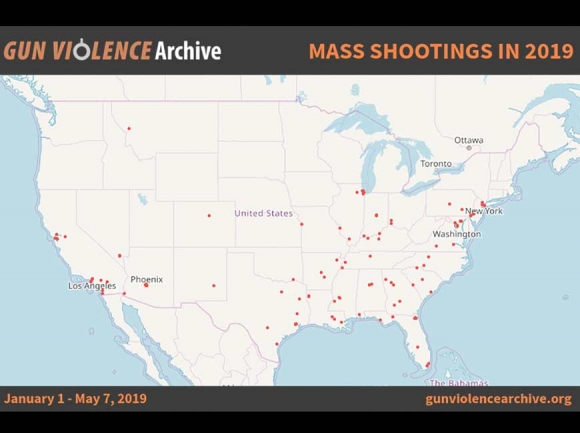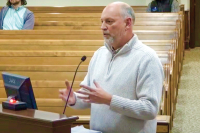Searching for answers: Mass shootings linked to multiple factors

A senseless tragedy. Those words are repeated over and over again in the aftermath of mass shootings in the United States.
These violent acts are even more disturbing when society isn’t able to pinpoint a motive for such a crime. The unknown entices fear and makes people hyper aware that something so tragic could happen anywhere at anytime to anyone. There was a time not so long ago most parents didn’t have to worry about their children’s safety at school. There was a time when small businesses didn’t think they needed to train their employees on what to do if an active shooter walks through the door. And there was a time when rural America thought it was safe from random gun violence.
Those days are over, and nothing has made that more apparent than the recent shooting at UNC-Charlotte that left four injured and two dead — including 21-year-old Riley Howell of Waynesville. While many mass shooting victims will remain strangers that are all-too-soon forgotten as the news cycle moves on to the next tragedy, Howell’s face and heroic acts will never be forgotten by the small community he called home.
While still mourning the loss of Howell and 19-year-old classmate Reed Parlier on April 30, there have been another 10 mass shootings — five more dead and 39 injured — in the U.S., according to Gun Violence Archive.
When it hits too close to home, the questions of “Why?” and “How do we stop it?” come to the forefront of everyone’s mind. As Kevin Westmoreland commented during Howell’s funeral service at Lake Junaluska, “When someone you love dies traumatically, you immediately look for an answer as to why. The pain is so acute, it’s so strong, you want it to go away as quickly as possible.”
Many people believe stricter firearms regulations should be in place to prevent guns from getting into the wrong hands, while opponents say criminals will find a way to get a gun no matter what the law says. Others blame the increase in mass shootings on changes in society, a younger generation’s inability to deal with life’s failures and disappointments or an increase in substance abuse and mental illness.
Related Items
While it’s important for law enforcement to try to identify a motive for prosecution purposes, psychiatric experts say society needs to move away from trying to search for a motive and toward recognizing the warning signs before a shooting occurs.
In a Jan. 14 Psychiatric Times article, Dr. James Knoll, director of forensic psychiatry at SUNY Upstate Medical University in Syracuse, says society needs to focus more deeply on recognizing the major risk factors that increase the risk of violence, being able to identify the red flags and reducing the likelihood of these offenders obtaining lethal weapons.
Knoll said a previous history of violence is the most obvious risk factor, but to also look for a history of substance abuse, a history of child abuse or bullying, witnessing violence between parents, a preoccupation with death or weapons, poor control of anger and social isolation.
“Unfortunately, these risk factors are far too prevalent in the general population to be of practical use in identifying would-be shooters and may not apply to mass shooters,” he said. “For example, there is often no history of serious past violence in these individuals. Furthermore, neither the Secret Service nor the FBI has found a specific psychological profile or checklist of personality traits that can be used to predict who will become a mass shooter.”
As for the role mental illness plays, Knoll said the correlation between mental illness and violence is weak, but an untreated serious mental illness can be a risk factor for violence. A recent FBI report on 63 active shooters between 2000 and 2013 found that only 25 percent, or 16, of them had ever had a mental illness diagnosis. Of those 16, only three had a psychotic disorder diagnosis.
“With regard to mass shooters specifically, there is little documented clinical evidence linking these perpetrators to major mental illnesses like schizophrenia or bipolar disorder,” Knoll said. “On the other hand, some evidence suggests that many mass shooters have been preoccupied with feelings of social persecution and fantasies of revenge for some type of perceived injustice.”
The FBI report identified various grievances in 79 percent of the shooters — mostly in regard to interpersonal or employment actions they perceived against them. The FBI report also found that shooters often intentionally or unintentionally reveal their violent intent to others beforehand or make threats of violence, especially with perpetrators 18 and younger.
“While solid, evidence-based methods of preventing mass shootings are still lacking, we believe that progress will come through work on a number of fronts,” Knoll said.
He emphasized the importance of threat assessment teams working inside the schools to help identify planned attacks. He also talked about the important role the media can play in reducing the number of mass shootings in the country by refusing to publicize the shooter’s name, picture and motives.
“There is reason to believe that such notoriety may encourage copy-cat killers, bent on outdoing the previous shooter,” he said. “Surely, proactively uncovering homicidal plots and removing the lethal means of carrying them out makes far more sense than retroactively speculating on a shooter’s motives.”
Dr. Linda Woolf, a professor of psychology at Webster University, wrote a 2018 article for Psychology Today discussing mass shootings and gun control. While she acknowledges all the aforementioned factors — mental illness, bullying, violent video games, bigotry, the role of masculinity and power in our society — she said the core of the issue is that people are being killed by guns.
“The key feature that separates the U.S. from other nations around the globe is the availability and access to guns, particularly highly destructive semi-automatic weapons of war,” she said.
The U.S. represents 5 percent of the world’s population but makes up between 35 and 50 percent of the world’s gun ownership — that’s 88 guns per 100 people.
“In the hands of someone who is influenced by any of the other factors described above, we have a recipe for tragedy,” Woolf said. “Until the U.S. deals with the role of guns in mass shootings and establishes common sense restrictions, we will continue to be plagued by mass shootings. Thoughts and prayer will not end the violence impacting people wherever we gather for fun, support or learning.”
Mass shootings in the U.S.
2014: 270
2015: 335
2016: 382
2017: 346
2018: 340













